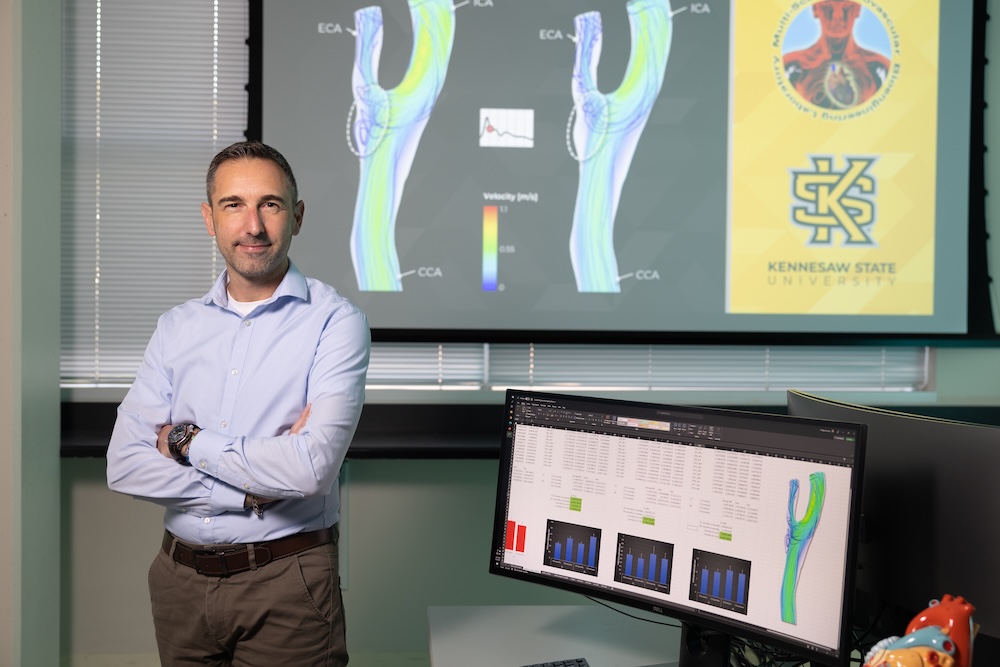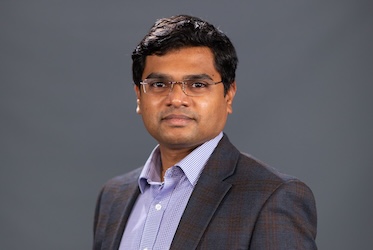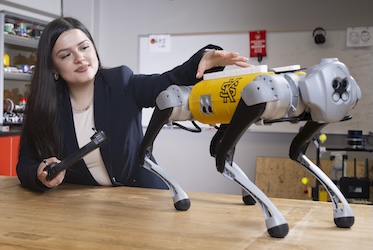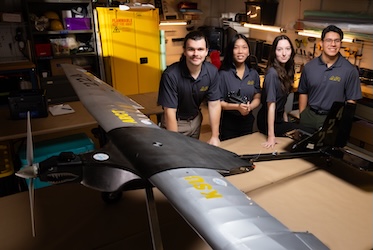
Kennesaw State researcher receives American Heart Association grant to study heart valve disease
KENNESAW, Ga. | Feb 3, 2025

Titled “A Novel Microphysiological Valve-on-Chip for Elucidating the Mechano-Etiology of Bicuspid Aortic Valve Disease,” Sucosky’s project aims to build a device replicating the structure and function of the bicuspid aortic valve. The study investigates how unusual stress on the valve leads to its hardening, causing significant health issues to begin earlier than normal.
Sucosky's team in the Multi-Scale Cardiovascular Bioengineering Laboratory (MSCBL), is developing an advanced in-vitro device designed to simulate the conditions of both normal and bicuspid aortic valves. This will help uncover the biological triggers behind early valve degeneration. Their work could lead to alternative treatments or methods to slow or stop disease progression.
Bicuspid aortic valve disease occurs when individuals are born with a deformed valve, which, unlike the normal heart valve, starts to calcify at an unusually early age. Normally, heart valve calcification happens around 65 years of age, but those with a bicuspid aortic valve often face serious complications by their 30s, typically requiring valve replacement surgery. This early calcification not only accelerates the disease but also presents a major challenge, as replacement valves do not typically have a long lifespan, resulting in multiple surgeries over their lifetimes.
“This condition can be a real burden for patients, especially when you consider that they might face repeated surgeries starting at a young age,” said Sucosky, who teaches in the Southern Polytechnic College of Engineering and Engineering Technology. “We want to understand the underlying mechanisms of the calcification process and find ways to slow it down or even stop it altogether.”
Sucosky’s groundbreaking research on bicuspid aortic valve disease has garnered attention not only from the American Heart Association but also from his colleagues at KSU. Southern Polytechnic College of Engineering and Engineering Technology Dean Lawrence Whitman said his work is significant for both the academic community and healthcare.
“Dr. Sucosky’s research is a shining example of the impact our faculty has at the intersection of engineering, science, and healthcare,” Whitman said. “His work not only pushes the boundaries of cardiovascular research, but it also holds the potential to change lives by offering new insights and treatments for heart valve disease.”
The research is based on the hypothesis that the unusual shape of the bicuspid valve causes blood to flow irregularly, putting extra stress on the valve. These abnormal forces may be a major contributor to the aggressive calcification seen in the bicuspid valve. To test this theory, Sucosky's lab is developing a cutting-edge “valve-on-chip” device capable of mimicking the blood flow and mechanical forces exerted on a valve in the body. This device will allow researchers to study how these forces change the biological processes in valve tissue.
Sucosky's research could lead to breakthroughs not only in understanding bicuspid aortic valve calcification but also in broader cardiovascular diseases. By using this device, Sucosky hopes to uncover molecular pathways that could one day be targeted with pharmaceutical treatments, offering a non-surgical alternative to valve replacement.
“This is a critical area of research,” Sucosky said. “We could potentially develop drug-based therapies that would stop the calcification process, sparing patients from the need for multiple surgeries.”
The AHA funding, totaling nearly $200,000 over two years, is a significant boost to Sucosky's MSCBL Laboratory and its heart research. The team includes undergraduate students, who have contributed to the design and simulation of the device, and collaborators such as Dr. Kartik Balachandran at the University of Arkansas, whose previous work on similar devices has provided a foundation for Sucosky’s project.
“The collaboration between engineers, biologists and clinicians is essential,” Sucosky said. “The mechanical forces we study must be understood in the context of biological systems, and the insights we gain could help inform both the development of new treatments and the refinement of surgical approaches.”
In the near future, Sucosky plans to expand the scope of his research to include other cardiovascular diseases, such as aneurysms and atherosclerosis, that abnormal mechanical forces may also drive. The goal is to develop a versatile tool that can be used to investigate a range of cardiovascular conditions and provide new insights into their causes and treatments.
“This project is a long-term endeavor, but the potential impact is huge,” Sucosky said. “Not only could we change how we think about and treat valvular disease, but we could also open the door to a broader understanding of how mechanical forces contribute to many other cardiovascular conditions.”
– Story by Raynard Churchwell
File photo
Related Stories

Kennesaw State University researcher, students explore clean energy storage solutions

Kennesaw State student exploring the use of robotics in agriculture

Kennesaw State alumna building a legacy of opportunity for construction management and engineering students

Kennesaw State student competition teams reflect vibrant culture of innovation
A leader in innovative teaching and learning, Kennesaw State University offers undergraduate, graduate, and doctoral degrees to its more than 47,000 students. Kennesaw State is a member of the University System of Georgia with 11 academic colleges. The university’s vibrant campus culture, diverse population, strong global ties, and entrepreneurial spirit draw students from throughout the country and the world. Kennesaw State is a Carnegie-designated doctoral research institution (R2), placing it among an elite group of only 8 percent of U.S. colleges and universities with an R1 or R2 status. For more information, visit kennesaw.edu.














